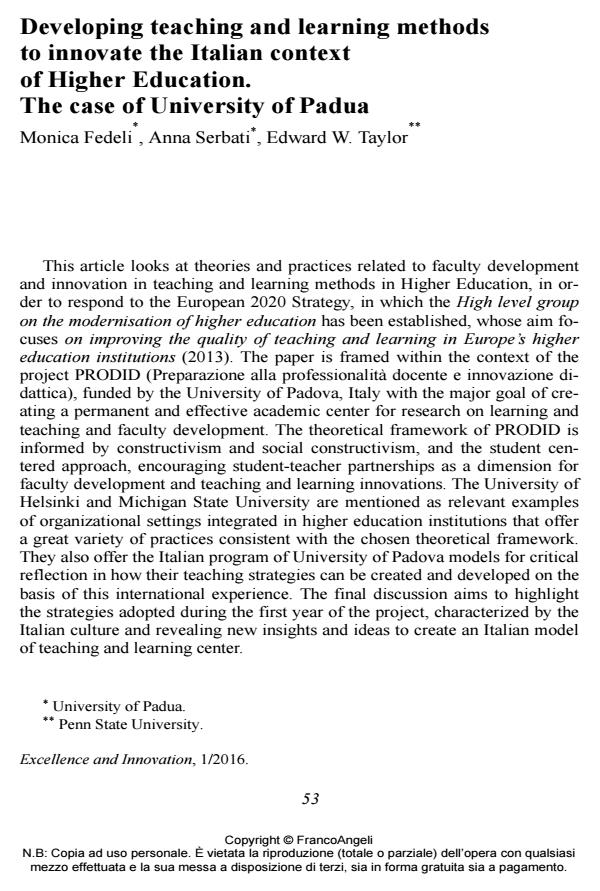Developing teaching and learning methods to innovate the Italian context of Higher Education. The case of University of Padua
Titolo Rivista EXCELLENCE AND INNOVATION IN LEARNING AND TEACHING
Autori/Curatori Monica Fedeli, Anna Serbati, Edward W. Taylor
Anno di pubblicazione 2016 Fascicolo 2016/1
Lingua Inglese Numero pagine 18 P. 53-70 Dimensione file 71 KB
DOI 10.3280/EXI2016-001004
Il DOI è il codice a barre della proprietà intellettuale: per saperne di più
clicca qui
Qui sotto puoi vedere in anteprima la prima pagina di questo articolo.
Se questo articolo ti interessa, lo puoi acquistare (e scaricare in formato pdf) seguendo le facili indicazioni per acquistare il download credit. Acquista Download Credits per scaricare questo Articolo in formato PDF

FrancoAngeli è membro della Publishers International Linking Association, Inc (PILA)associazione indipendente e non profit per facilitare (attraverso i servizi tecnologici implementati da CrossRef.org) l’accesso degli studiosi ai contenuti digitali nelle pubblicazioni professionali e scientifiche
This article looks at theories and practices related to faculty development and innovation in teaching and learning methods in Higher Education, in order to respond to the European 2020 Strategy, in which the High level group on the modernisation of higher education has been established, whose aim focuses on improving the quality of teaching and learning in Europe’s higher education institutions (2013). The paper is framed within the context of the project PRODID (Preparazione alla professionalità docente e innovazione didattica), funded by the University of Padova, Italy with the major goal of creating a permanent and effective academic center for research on learning and teaching and faculty development. The theoretical framework of PRODID is informed by constructivism and social constructivism, and the student centered approach, encouraging student-teacher partnerships as a dimension for faculty development and teaching and learning innovations. The University of Helsinki and Michigan State University are mentioned as relevant examples of organizational settings integrated in higher education institutions that offer a great variety of practices consistent with the chosen theoretical framework. They also offer the Italian program of University of Padova models for critical reflection in how their teaching strategies can be created and developed on the basis of this international experience. The final discussion aims to highlight the strategies adopted during the first year of the project, characterized by the Italian culture and revealing new insights and ideas to create an Italian model of teaching and learning center.
Parole chiave:Faculty development; teaching and learning methods; teaching and learning centre.
- Entrepreneurship as a Special Pathway for Employability Carlo Terzaroli, in New Directions for Adult and Continuing Education /2019 pp.121
DOI: 10.1002/ace.20346
Monica Fedeli, Anna Serbati, Edward W. Taylor, Developing teaching and learning methods to innovate the Italian context of Higher Education. The case of University of Padua in "EXCELLENCE AND INNOVATION IN LEARNING AND TEACHING" 1/2016, pp 53-70, DOI: 10.3280/EXI2016-001004